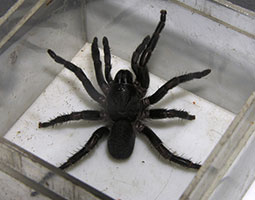Seqocrypta jakara
Description

Brush-footed trapdoors are a medium-sized spider with a darkly mottled brown abdomen. They have tiny stumpy spinnerets located on the posterior, ventral surface of the abdomen. The head is brown to black in colour. Their common name is derived from the prominent hairs located on the tips of their feet (tarsi).
Brush-footed trapdoors are primitive spiders that belong to the Mygalomorphae suborder. They are characterised by ‘booklungs’ (external bags used for breathing) and large, backwards facing fangs. In order to bite, they must rear up to strike down to deliver their toxin. Despite being reluctant biters, brush-footed trapdoors should be handled with caution as their venom has the capacity to be toxic to humans.
These spiders construct a burrow in the soil. Females remain in the burrows, but males are sometimes encountered late winter and spring wandering in search of a mate. The entrance to the burrow is used to ambush passing insects.
Adaptations
- Constructs a burrow to ambush prey and to hide from predators
- Camouflage makes the burrow difficult for predators to find
Feeding relationships
- What I eat: invertebrates that live in the leaf litter
- What eats me: large centipedes, lizards, birds
Interesting facts
Brush-footed trapdoors can climb smooth vertical surfaces, including glass.